

-
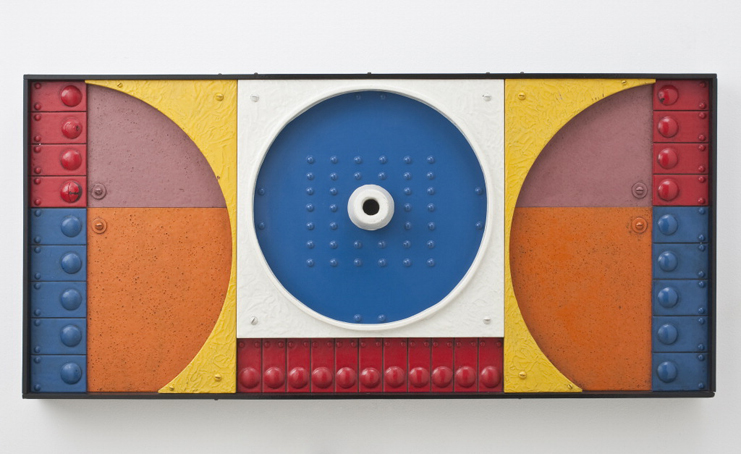
Bonus (1967)
Jackson Woolley
Jackson Woolley and his wife, Ellamarie, were among the first to develop the art of modern enameling on the West Coast, quickly becoming San Diego’s most celebrated midcentury modern artist couple. They led by example, teaching themselves as they participated in architectural projects for the city. Jackson, in particular, felt strongly about modern design, art in public spaces, and the built environment. He often picked up new ideas while bicycling along the Tenth Avenue Terminal docks, not far from their house in Point Loma. He built constructions of entirely new materials, wood, fiberglass, and polyester resin that echoed the “shapes of shipping, flat flanges and rivet patterns of the waterfront.” In 1969 one of these large wall constructions, Bonus, was included in Objects: USA (and the eponymous book), a traveling exhibition of craft from the collection of the S. C. Johnson Company, which debuted at the Smithsonian Institution.
Polyester resin, paint, wood 19 1/2 x 40 x 4 in
Courtney Cutter and Marc Sagal Collection. Photograph by Steve Oliver © Mingei International Museum -
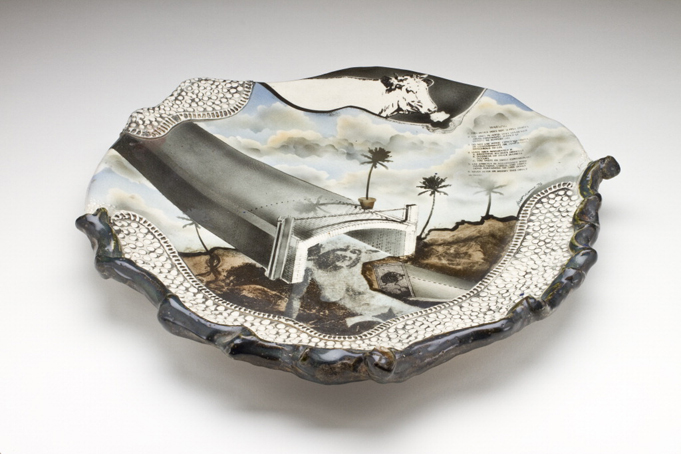
Warning: Never Alter This Cow . . . On a Point . . . Made in U.S.A.—C (1976)
Les Lawrence
Les Lawrence worked in clay, making “vessels in subject, but not functional,” and he was among the first San Diego ceramists to transfer photographic imagery onto clay with photo silkscreen printing. He described this as “sculpture, photography, and printmaking combined,” and he called his choice of images “purposely ambiguous.” He also introduced new technology and “important innovations to the Grossmont College Ceramics Department," which later included computer applications for ceramics and glaze calculation software.
Clay with photo silkscreen 19 x 19 x 3 1/2 in
Irina and Erik Gronborg Collection. Photograph by Steve Oliver © Mingei International Museum -
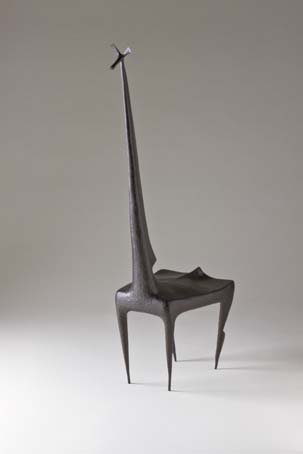
Giraffe (ca. 1965)
Jack Boyd
Jack Boyd became well known in San Diego for his jewelry and sculpture. With no formal art training, Boyd had an early gift for creating compelling shapes in metal, and “became a professional silver and goldsmith at age seventeen.” He was billed as “one of San Diego’s youngest silversmiths,” and he joined the Allied Craftsmen in his early twenties. He explored such techniques and materials as enamel on copper, wood, ceramics, welded steel, and—in the case of much of his distinctive jewelry—welded bronze.
Welded Steel 13 x 7 x 26 in
Private Collection. Photograph by Steve Oliver © Mingei International Museum -
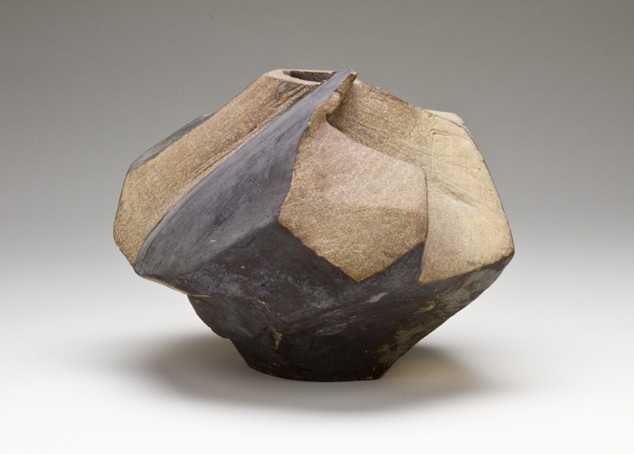
Pot (ca. late 1950s)
Malcolm McClain
Malcolm McClain is best known for his experimental and “free-from-form” ceramics.
Slab built stoneware 13 1/2 x 12 x 10 1/2 in
Laurence McGilvery Collection. Photograph by Steve Oliver © Mingei International Museum -

Upon Whose Bosom Snow as Lain (1983)
Kay Whitcomb
Kay Whitcomb became one of the first to teach enameling in San Diego when she introduced classes in the medium in 1956 at the Art Center in La Jolla. Her distinctive images and techniques for surfacing were often combined with words, phrases, and proverbs. This panel belonged to the late Sim Bruce Richards, AIA, and his wife, Janet Richards.
Enamel on steel 12 1/2 x 14 x 2 in
Janet Richards Collection. Photograph by Steve Oliver © Mingei International Museum -

Doors (ca. 1970)
Kay Whitcomb
A pair of eye-popping enamel-on-steel doors, made during Kay Whitcomb’s residency at Crahait, was exhibited in 1971 at California Design 11. Each door was a single nine-and-a-half-feet-high sheet of steel. Photographer Richard Gross took them out into the desert. This image for the exhibition catalog presents Whitcomb’s double doors standing alone in the dunes like a colorful monolith.
Enamel on steel 9 1/2 x 5 1/4 ft
Reform Gallery Collection. Photograph by Richard Gross. California Design 11, 1971. California Design Archive, Oakland Museum of California © Mingei International Museum. Photograph provided by California Design Archive, Oakland Museum of California -

Bowl (ca. 1959)
Rhoda Lopez
An accomplished potter who studied with Maija Grotell at the Cranbrook Academy of Art in Bloomfield Hills, Michigan, Rhoda Lopez moved to San Diego in 1959 to join the faculty at the Art Center in La Jolla, California. After the Art Center School closed in 1964, Lopez taught ceramics classes for the University of California extension program in her studio, Clay Dimensions. While she continued to exhibit in major national competitions and invitationals like those held at the Wichita Art Association, the Everson Museum, Scripps College, and at the California Design series at the Pasadena Art Museum, Lopez also exhibited locally with the Allied Craftsmen of San Diego. Although she never abandoned more traditional potter’s wares, the work she exhibited began to demonstrate a new emphasis on panels of textured bricks and sculptural tiles for architectural installation. In the 1960s Lopez dramatically refined this concept, producing large fountain walls of sculptural stoneware with organic, plant and insect-inspired motifs. She worked with Taliesin fellow Sim Bruce Richards, one of San Diego’s most progressive architects, on commissions for planters, fireplaces, and fountains that placed Lopez’s work in a category of its own in San Diego.
Stoneware 10 1/2 x 14 1/2 in
Mingei International Museum, Gift of Horton & Chiyo Telford Mingei International Museum © 2011 -

Bowl (ca. 1970s)
Frank Papworth
A protégé of ceramist Martha Longenecker (with whom he studied at San Diego State College), Frank Papworth was born in Japan but grew up in San Diego. After receiving a BA from San Diego State University in 1959, Papworth studied at the University of California, Los Angeles, with Laura Andreson, receiving his MA in 1961. Papworth became an art professor at San Diego State in 1967 and was a member of the Allied Craftsmen of San Diego. He exhibited in California Design 10 (1968) at the Pasadena Art Museum. After Longenecker retired, Papworth took over the ceramics program at San Diego State University. He also served as president of the Allied Craftsmen in 1966 and 1970, and was active in both the contemporary arts and the Asian arts committees of the San Diego Museum of Art.
Clay 14 x 16 1/2 in
Mingei International Museum, Gift of Edmund Burke Mingei International Museum © 2011 -
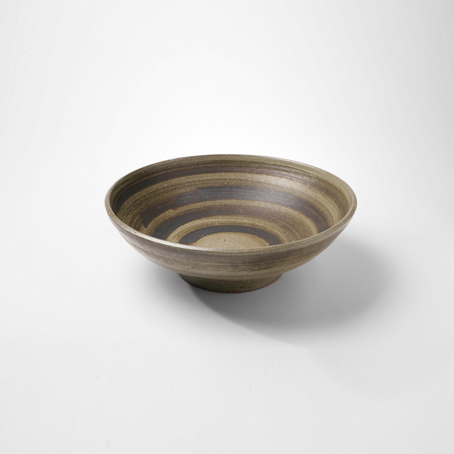
Bowl (ca. 1970s)
Frank Papworth
A protégé of ceramist Martha Longenecker (with whom he studied at San Diego State College), Frank Papworth was born in Japan but grew up in San Diego. After receiving a BA from San Diego State University in 1959, Papworth studied at the University of California, Los Angeles, with Laura Andreson, receiving his MA in 1961. Papworth became an art professor at San Diego State in 1967 and was a member of the Allied Craftsmen of San Diego. He exhibited in California Design 10; (1968) at the Pasadena Art Museum. After Longenecker retired, Papworth took over the ceramics program at San Diego State University. He also served as president of the Allied Craftsmen in 1966 and 1970, and was active in both the contemporary arts and the Asian arts committees of the San Diego Museum of Art.
Clay 5 1/2 x 16 1/2 in
Mingei International Museum, Gift of Edmund Burke Mingei International Museum © 2011 -

Pot (ca. 1960s)
Ilse Ruocco
Their Fifth Avenue Design Center building housed Lloyd’s firm, Ilse’s retail space and interior design business, and the offices of other architects, photographers, and landscape architects. She received a BA degree from University of California, Los Angeles, and an MA from Columbia University. Before coming to San Diego State in 1934, she taught at Santa Ana Junior College. Ruocco's textile designs won first prize at the National Textile Exhibition in North Carolina in 1948 and 1949, as well as the Museum of Modern Art in 1949. Examples of these were published in Arts and Architecture magazine. Ilse was the founding chairperson of the Allied Craftsmen of San Diego in 1946, but only served in that capacity for one year.
Earthenware 9 1/4 x 14 11/16 in
Mingei International Museum, Gift of Ruth Granstrom in Memory of Evangeline LeBarron Mingei International Museum © 2011 -
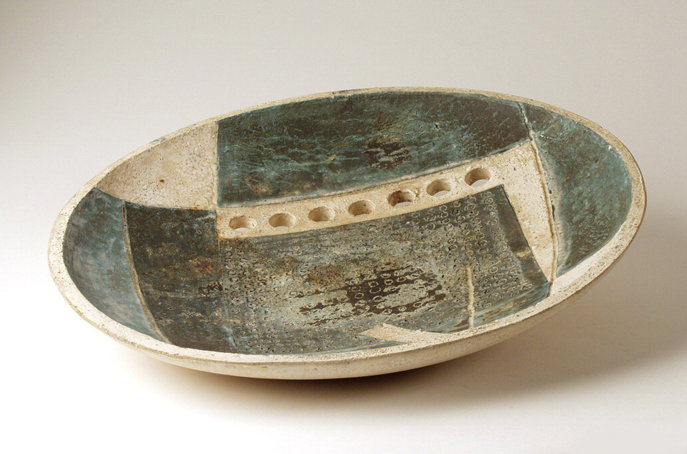
Platter (ca. 1945)
Ilse Ruocco
Ilse Ruocco taught ceramics and design at San Diego State College from 1934 to 1967. She founded the Environmental and Interior Design Program at San Diego State and introduced modern furniture, paintings, and objects into the homes of forward-thinking San Diegans. With her husband, architect Lloyd Ruocco, they were among the most influential proponents of contemporary design in San Diego's post-war era. Their Fifth Avenue Design Center building housed Lloyd’s firm, Ilse’s retail space and interior design business, and the offices of other architects, photographers, and landscape architects. She received a BA degree from University of California, Los Angeles, and an MA from Columbia University. Before coming to San Diego State in 1934, she taught at Santa Ana Junior College. Ruocco's textile designs won first prize at the National Textile Exhibition in North Carolina in 1948 and 1949, as well as the Museum of Modern Art in 1949. Examples of these were published in Arts & Architecture magazine. Ilse was the founding chairperson of the Allied Craftsmen of San Diego in 1946, but only served in that capacity for one year.
Clay 18 1/4 x 18 1/4 in
Mingei International Museum, Gift of Ruth Granstrom in Memory of Evangeline LeBarron Mingei International Museum © 2011 -
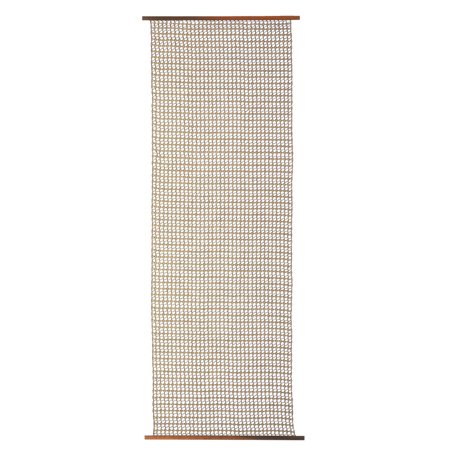
Brown Tracery (1957)
Eve Gulick
Eve Gulick took her first weaving course at Mills College in the late 1930s, because her "husband wanted hand woven ties." She began her weaving career making ties and skirt fabrics using Dorothy Liebes's simplified techniques of plain weave and simple twill. After a pause during the World War II, she returned to weaving after moving to San Diego in 1950. She joined the Allied Craftsmen of San Diego, and exhibited woven works in national shows at such institutions as the Museum of Contemporary Crafts in New York, the de Young Museum, the Wichita Art Association, and the Saint Paul Gallery in Minnesota. These works were still controlled by the fundamentals of warp and weft, but incorporated uneven spacing, a "much greater variety of materials," and the idea that "each thread could do its own thing, like the separate instruments in a string quartet." Gulick's work, particularly room dividers and wall hangings, paralleled contemporary architecture. She was described by her friend Martha Longenecker as a leader in the field of inventive structure of design and use of organic materials interlocked with fiber. In 1982 Mingei International Museum (founded by Longenecker) honored Eve Gulick with a retrospective show.
Linen 114 x 37 1/2 in
Mingei International Museum, Gift of the artist Mingei International Museum © 2011 -
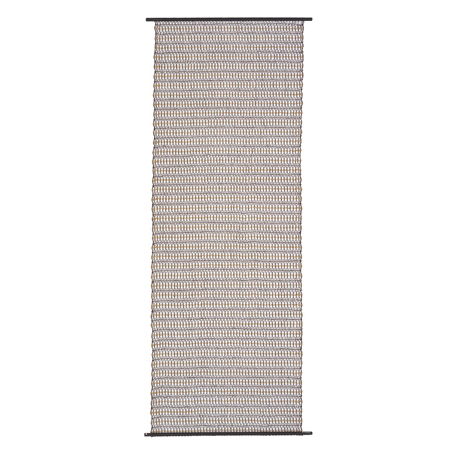
Black Tracery (1961)
Eve Gulick
Eve Gulick took her first weaving course at Mills College in the late 1930s, because her "husband wanted hand woven ties." She began her weaving career making ties and skirt fabrics using Dorothy Liebes's simplified techniques of plain weave and simple twill. After a pause during the World War II, she returned to weaving after moving to San Diego in 1950. She joined the Allied Craftsmen of San Diego, and exhibited woven works in national shows at such institutions as the Museum of Contemporary Crafts in New York, the de Young Museum, the Wichita Art Association, and the Saint Paul Gallery in Minnesota. These works were still controlled by the fundamentals of warp and weft, but incorporated uneven spacing, a "much greater variety of materials," and the idea that "each thread could do its own thing, like the separate instruments in a string quartet." Gulick's work, particularly room dividers and wall hangings, paralleled contemporary architecture. She was described by her friend Martha Longenecker as a leader in the field of inventive structure of design and use of organic materials interlocked with fiber. In 1982 Mingei International Museum (founded by Longenecker) honored Eve Gulick with a retrospective show.
Linen 101 x 36 in
Mingei International Museum, Gift of the artist Mingei International Museum © 2011 -

Weather Report #522 (ca. 1950s)
Ellamarie Woolley
Born in San Diego, Ellamarie Woolley studied art at San Diego State College. She painted two murals on the campus, Packing Oranges and Sailors Going to Hell, in 1936 as part of a group commissioned with WPA funds. She and her husband, Jackson Woolley, were among the first to develop the art of modern enameling on the West Coast. Woolley joined the Allied Craftsmen of San Diego in 1949 and was active in the group until her death in 1976. Her work was exhibited in major exhibitions including Objects: USA, the California Design series held at the Pasadena Art Museum, and Craftsmanship in a Changing World at the Museum of Contemporary Crafts in New York. Over time, her work evolved from figurative designs and abstractions on small copper plates to large-scale architectural murals that exploited the support medium, copper, as sculptural material in its own right. In the late 1960s, Woolley produced reductive abstract compositions that left “no place to hide” and responded to the shaped canvas, pure color, and hard-edge quality of West Coast painters.
Metal, enamel 10 1/4 x 13 1/4 x 1 in
Mingei International Museum, Gift of Kirk Butler Mingei International Museum © 2011 -

Body Ornament (1971)
Mona Trunkfield
Mona Trunkfield studied at San Diego State College in the late 1950s with painter Jean Swiggett and sculptor/woodworker John Dirks. She received a BA in art education and taught arts and crafts in Chula Vista, California, at the junior high and high school levels. One of Trunkfield's former students urged her to enroll in the jewelry classes offered at State by metalsmith Arline Fisch. Subsequently, Trunkfield completed an MA with Fisch in jewelry and metalsmithing. Trunkfield went on to study Danish goldsmithing in Copenhagen, and has exhibited at the Renwick Gallery in Washington, DC, the Minnesota Museum of Art, and the Museum of Contemporary Crafts in New York. Trunkfield also taught at San Diego State University and at Southwestern College in Chula Vista, California.
Plexiglas, silver 39 x 9 1/2 x 4 in
Mingei International Museum, Gift of Dave Hampton. Photograph by Chip Morton Mingei International Museum © 2011 -
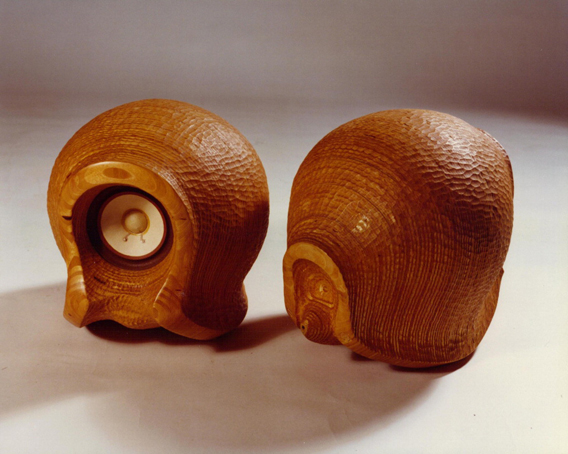
Animal Speakers (1972)
Lawrence Hunter
Lawrence "Larry" Hunter grew up in San Diego and received a BA from San Diego State College in the late 1950s. As an undergraduate, Hunter studied with John Dirks, who founded the furniture design program at San Diego State College, and Ilse Ruocco. While completing an MA at University of California, Los Angeles, Hunter worked in clay and was a teaching assistant for Laura Andreson. He also did postgraduate study in metals with Hudson Roysher and Victor Ries. Hunter was hired to teach general crafts and design classes at San Diego State in 1962, and later inherited the furniture design program from Dirks. Hunter was a member of the Allied Craftsmen of San Diego and exhibited furniture regularly in the California Design series at the Pasadena Art Museum and the California Crafts series at the Crocker Art Gallery in Sacramento. Hunter led the San Diego State furniture design program until the late 1980s, helping the furniture program to become a vital part of the community.
Laminated Finnish birch plywood 8 1/2 x 11 in
Collection of Dave Hampton and Gayle Kauihou. Photograph by Larry Hunter Mingei International Museum © 2011 -

Coil Fiber Form and Anima (Covered Form) (ca. mid-1970s;1975)
Carol Shaw-Sutton, Joan Austin
While working toward an MFA at Cranbrook Academy of Art, Joan Austin explored vessel shapes of natural fibers. In 1970 Joan took over the weaving program at San Diego State and joined the Allied Craftsmen in 1972, where she exhibited knotted, coiled, and twined objects and woven tapestries with the group. Examples from her series of “open form” structures in wrapped rattan were exhibited in the Allied Craftsmen spring show in 1977. Carol Shaw-Sutton was another fiber artist who was working on her BA at San Diego State in the late 1960s and early 1970s. Born and raised in Los Angeles, Shaw-Sutton learned to knit and crochet at age five in a knitting group at the Bullock’s Westwood, where she “was the only knitter under 40.” Excursions to Little Tokyo and the Egg and the Eye on Wilshire Boulevard (the predecessor to the Craft and Folk Art Museum) fostered her interest in world craft and good food, and provided early encounters with contemporary American crafts.
coiled waxed linen, coiled raffia, linen thread Coil Fiber Form—8 x 5 1/2 x 5 in.; anima—diameter: 6 in., height: 7 in
Jonathan Austin Collection. Photograph by Steve Oliver © Mingei International Museum -

Bracelet for Jean; Feathers Bracelet (1980; 1973)
Svetozar Radakovich, Arline Fisch
Although Svetozar “Toza†and Ruth Radakovich made sculpture (Toza painted as well until the mid-1960s), their reputation in the 1950s came from their spectacular jewelry, which won national acclaim. They studied jewelry techniques in Denmark and France before finally moving to New York in 1955. Over the next four years, the Radakoviches studied metalworking at the School for American Craftsmen at the Rochester Institute of Technology. They also taught, exhibited and rapidly gained national recognition for their jewelry. A few years later, after moving to their hilltop in Encinitas, the ample space and new environment encouraged new directions in their work.
Besides her teaching and service to the field, Arline Fisch was “very religious†about entering her own work in exhibitions and competitions as a way to challenge herself and promote her work. Fisch set an example that encouraged her students to do the same, and her efforts drew attention to San Diego. People could see the high caliber of metalwork being done at San Diego State, and the evolution of Fisch's jewelry was documented in major exhibition catalogs of the 1960s and 1970s. Fisch had spent a year in Denmark on a Fulbright grant in 1956. By that time, she felt strongly about working with metal, and “Denmark and Sweden were where silver was happening in the fifties.â€
Sterling silver, gold, titanium, ebony and ivory; Sterling silver, leather, feathers 5 1/8 x 3 1/8 x 2 3/8 in; 6 x 3 in
Jean Radakovich Collection; Collection of the artist -

Wall Panel (ca. 1950s)
Barney Reid
Although talented in graphic design, printmaking, sculpture, and ceramics, Barney Reid was known for his enamel work and jewelry. In the 1950s Reid was one of the most nationally active of the early Allied Craftsmen, exhibiting enamels and enameled jewelry at the Walker Art Center, Oakland Museum, Wichita Art Association, Brooklyn Museum, and Art Institute of Chicago. He exhibited in several shows at the Museum of Contemporary Crafts in New York, including Enamels in 1959. Reid developed his own process for enameling that required as many as twelve to fifteen firings, and he had only a handful of enamels available at any given time. Next to the Woolleys, Reid was the best-known enamel artist in San Diego during the mid-1950s.
Enamel on copper set in a handmade mahogany frame 27 3/4 x 7 1/2 x 7/8 in
Private Collection. Photograph by Steve Oliver © Mingei International Museum -
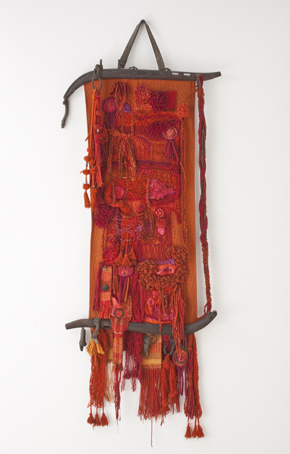
Stitchery Wall Hanging (ca. 1960s)
Barbara Waszack Chapman
Barbara Waszak Chapman brought something unquestionably new to the Allied Craftsmen. Her “richly colored, robustly textured, highly structured stitchery assemblages dominated the textile displays,” as Marilyn Hagberg put it in Craft Horizons. Waszak Chapman combined bright yarns with bits of clay, fur, bones, and found articles such as bridle bits, and parts of carts and harnesses in vibrant, surprising compositions at once earthy and baroque. The old Mexican yokes and found objects linked her work to Southern California and the influence of assemblage. Reviewers in different parts of the country responded to her fiber art with similar impressions. In 1967 Alan Meisel said that her hangings “evade nomenclature” while describing a San Francisco exhibition of Waszak Chapman and her students from Chula Vista. He also wrote, “Some of these things have an almost sacred power, a mysterious fetish-like aura.” This idea was echoed in 1968 by Sheldon Carey, who made reference to her “magic-imbued” composition of “fur, leather, beads, rocks and stitchery”, which was part of the Twentieth National Decorative Arts and Ceramics Exhibition at the Wichita Art Association.
Mixed media 25 x 62 x 3 1/2 in
Joe and Melissa Nyiri Collection. Photograph by Steve Oliver © Mingei International Museum
Mingei International Museum
San Diego's Craft Revolution-From Post-War Modern to California Design
San Diego's Craft Revolution –From Post-War Modern to California Design reveals to a new generation the important contributions of San Diego artist craftsmen to the post-war Southern California art scene. The progression from sleek modernism to unconventional handcrafted functional objects will be explored through furniture, doors, jewelry, and ceramics. The exhibit will also reveal a vibrant history of artist craftsmen who collaborated over the decades through San Diego State College and the Allied Craftsmen, a professional organization of local artists, which provided them a platform to receive national attention in the areas of architectural art, enameling, studio furniture, and body sculpture. Many of the craftspeople within this era in San Diego participated in major exhibitions including OBJECTS: USA and the California Design series held in Pasadena and Los Angeles. Featured artists will include Toza and Ruth Radakovich, Rhoda Lopez, Jack Hopkins, Arline Fisch, Ellamarie and Jackson Woolley, Larry Hunter, Kay Whitcomb, Ilse Ruocco, and James Hubbell.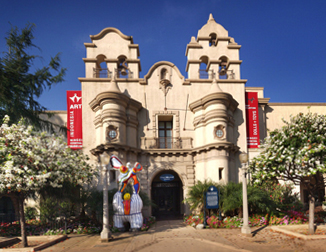
San Diego, CA 92101



















